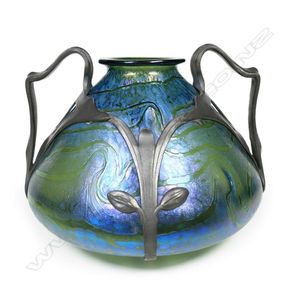Art Nouveau Fritz Heckert iridescent glass vase with pewter mount
A late 19th century Art Nouveau Fritz Heckert iridescent glass vase in pewter mount, the wavy and mottle glass in 'Changeant' decor, supported in a pewter Art Nouveau mount by Van Hauten. Maker's marks to base, height 17 cm. Note: Van Houten provided pewter mounts for both Loetz and Kralik after 1890. Hair crack to side.
You must be a subscriber, and be logged in to view price and dealer details.
Subscribe Now to view actual auction price for this item
When you subscribe, you have the option of setting the currency in which to display prices to $Au, $US, $NZ or Stg.
This item has been sold, and the description, image and price are for reference purposes only.
- Art Nouveau Period - The Art Nouveau period was a cultural movement that emerged in the late 19th century, and was characterized by its emphasis on natural forms, flowing lines, and a decorative, ornamental style. Art Nouveau was a reaction against the ornate and heavily stylized designs of the previous era, and sought to create a new, more organic aesthetic.
Art Nouveau was characterized by its use of sinuous, curving lines, as well as a focus on natural elements such as flowers, vines, and other organic shapes. Art Nouveau designers sought to create a total work of art, in which every element of a building or object was designed to be harmonious with the overall design.
Some of the most iconic examples of Art Nouveau design include the Paris Metro entrances designed by Hector Guimard, the works of the artist Alphonse Mucha, and the architecture of Victor Horta in Brussels.
The Art Nouveau period was at its peak between 1890 and 1910, but began to decline in popularity by the start of World War I. However, Art Nouveau remains an important influence on design and art to this day, and continues to be celebrated for its emphasis on natural forms and decorative style. - Decor Bois - "Decor bois" is a French term that translates to "wood decor" in English. It refers to decorative elements painted on porcelain items that simulate decorations in timber, such as carvings.
- Irridescent Glass - Iridescent glass has a shimmering or rainbow-like appearance due to the way it reflects light. It is created by applying a thin layer of metal oxides to the surface of the glass while it is still hot and malleable, which then creates an interference effect that produces a range of colours as the light reflects off the surface. The exact colours and patterns created by iridescent glass depend on the specific types of metal oxides used and the techniques used to apply them.
Iridescent glass was first developed in the late 19th century, and quickly became popular for use in decorative art glass and stained glass windows. Some of the most famous examples of iridescent glass were created by artists such as Louis Comfort Tiffany and his studio, who used it extensively in their distinctive lamps, vases, and other decorative objects.
This item has been included into following indexes:
